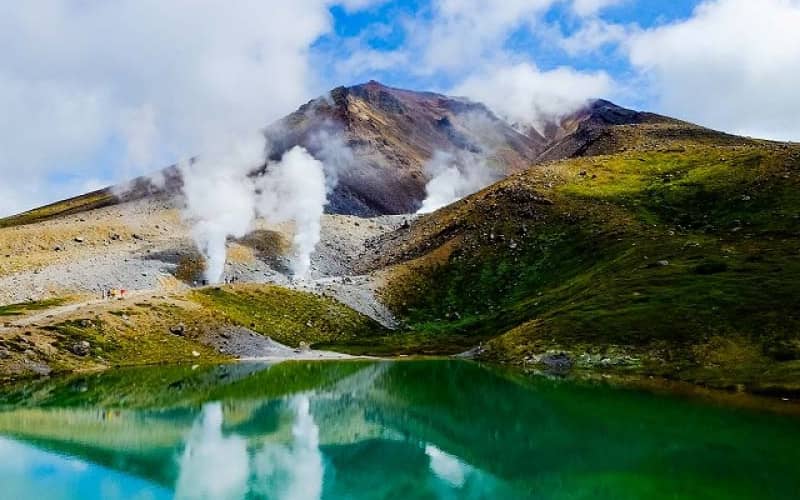Daisetsuzan National Park is a huge, rugged wilderness area on Japan’s northernmost island, Hokkaido. Established in 1934, it is a popular destination for hiking and camping, and one of the first places in the country to welcome both fall foliage and snowfall in the autumn.
One of the most mountainous and biggest national parks in the entire country, Daisetsuzan is larger than some Japanese prefectures and is home to a variety of rare species of flora and fauna. Daisetsuzan means “great snowy mountains” in Japanese, and the indigenous Ainu people of Hokkaido also call the area Kamui Mintara, meaning “playground of the gods.”
How to get to Daisetsuzan National Park
The easiest way to access Daisetsuzan National Park is from Asahikawa, the second-largest city on Hokkaido located in Kamikawa Subprefecture.
Asahikawa can easily be reached from Tokyo by air. Flights to Asahikawa Airport operate from both Haneda Airport and Narita Airport, and the total journey time is roughly 90 minutes.
It’s also possible to travel to Asahikawa Station from Sapporo, the capital of Hokkiado, on a Lilac or Kamui limited express train. The journey takes approximately 90 minutes and is fully covered by the JR Pass.
To get to Daisetsuzan from Asahikawa Station, you can take a 90-minute bus ride to Asahidake Onsen, one of the main resort towns in the park and a convenient hub from which to explore the surrounding wilderness. Buses also operate from Asahikawa Station to other popular areas of the park, although these are less frequent.
If you look at a map of Daisetsuzan, you’ll see that many of the smaller onsen towns and popular attractions are quite remote, and cannot be accessed by public transportation. Therefore, you may wish to consider renting a car so that you can more easily get around the park.
What to see in Daisetsuzan
The main attraction of Daisetsuzan Natural Park is the volcanic mountain groups that dominate this alpine region. These stratovolcanoes are grouped into 3 categories;
- Daisetsuzan Volcanic Group — Located in the north of the park, this range includes Asahidake (Mount Asahi), the highest peak in all of Hokkaido, as well as a number of other active volcanoes.

Mount Asahi - Tokachi Volcanic Group — Includes Mount Tokachi, and lies in the southwest of the park north of the Yubari and Hidaka Mountains.

Mount Tokachi - Shikaribetsu Volcanic Group — Located in the east of the park. Includes Mount Ishikari, the source of the Ishikari River, which is the longest river on Hokkaido.

Mount Ishikari
You can also observe a large variety of rare wildlife in Daisetsuzan, some unique to the region. This includes a significant population of brown bears, as well as:
- The Pika – A small mammal that lives in rocky areas at high altitudes in the colder areas of Hokkaido. Identifiable by its rounded ears, stubby limbs, and the absence of a tail.
- The Ezo Red Fox – A subspecies of the red fox family which is extremely common in the park.
- Parnassius eversmanni daisetsuzanus – One of 5 species of alpine butterfly native to Hokkaido, this particular species can only be found on Mount Daisetsu and is identifiable by its semi-transparent yellow wings.
- Siberian Rubythroat – A small bird often seen in the forests on the slopes of Mount Daisetsu and known for its distinctive warble. The male of the species is easily identifiable by its bright orange throat.
The park is also home to several endemic plant species, many exclusively found in the vicinity of Lake Shiaribetsu, the only natural lake in Daisetsuzan.
What to do in Daisetsuzan Natural Park
The most popular activity for visitors to Daisetsuzan is to hike one of the many gorgeous trails found throughout the park. One of the most famous is the Ginsendai Trailhead, widely considered to be one of the best places for early autumn leaves viewing in Hokkiado.
If decide to hike the tallest peak, Asahidake, you can take in the mysterious sight of a giant SOS sign made out of massive birch logs located near the summit. Although it is believed to have been created by hikers who got lost, the authors of the sign have never been identified to this day.
The National Park is also home to a huge number of charming onsen resorts where you can relax in soothing hot springs amidst stunning scenery. These include:
- Asahidake Onsen – Located at the base of Mount Asahi, this town is a popular place to begin exploring the surrounding mountainous terrain. It is also considered one of the best ski resorts on Hokkaido due to its extended ski season during the winter, from November to early May.
- Kogen Onsen – This remote onsen consists of only one small inn, but is poplar as the start of a circular hiking trail through the surrounding highlands. However, as the area is densely populated by brown bears, it’s advisable to attend a safety lecture at the on-site bear information center before setting off!
- Nukabira Gensenkyo – A base for exploring the Higashi-Taisetsu area of the park, Nukabira Gensenkyo boasts naturally flowing hot springs as well as stunning views over the nearby Lake Nukabira.
Finally, if you aren’t much of a hiking enthusiast but feel like scaling one of Daisetsuzan’s peaks anyway, consider taking a ride on the Kurodake Ropeway. This cable car system will take you up the summit of Mount Kurodake to a viewpoint with stunning vistas over large areas of the park.
